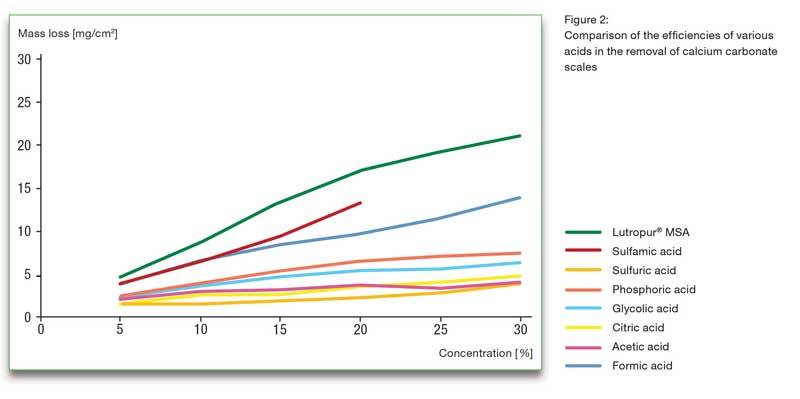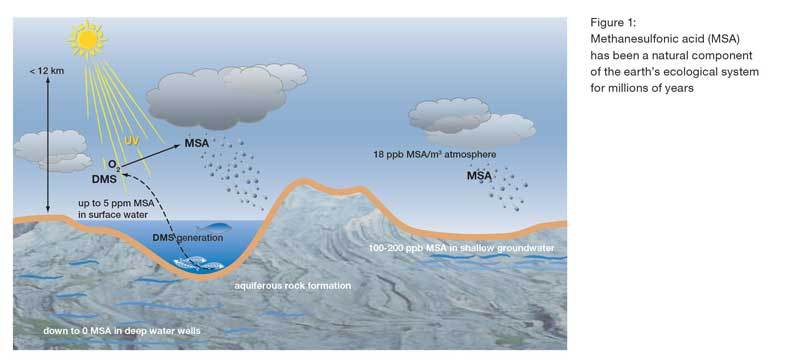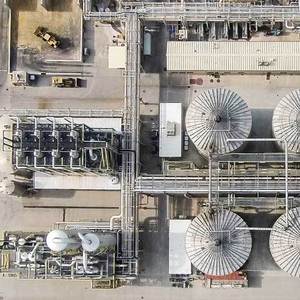New Acid Solution Improves CIP Programs




PHOTO: VERSCHELDEN PHOTOGRAPHY
June 7, 2016
BY Brian Hoskins
Ethanol producers continually struggle with fouling of process equipment and how best to remove it. The accumulation of deposits on equipment surfaces and in pipes can be extremely detrimental to the overall efficiency of an ethanol plant. Contamination can cripple operations, while fouling and scale formation significantly can impair equipment function. The bioconversion of corn introduces a unique combination of feedstock, processing aids and yeast, all with unique chemical properties and processing steps that include wide temperature, pH and pressure fluctuations. This results in residual organic and inorganic materials that collect and become points for contamination and scaling that interfere with the regular function of equipment, such as distillation columns, evaporators and heat exchangers. A well-designed clean in place (CIP) regimen between fermentations and shutdowns can decrease plant downtime significantly and mean the difference between profitability and loss.
Clean in place systems often include in some combination rinsing with water, a caustic cleaning step and an acid wash. Every plant is unique with different engineering, corn, processes, age, piping, water quality, size, location, management and operators and, thus, has unique considerations and requirements when designing the most cost-effective CIP system. Selecting the right chemistries and optimizing the number of steps, concentrations, residence times and temperatures throughout can have a substantial economic impact.
Alternative CIP chemicals can provide significant advantages, if the plant is capable of handling the innovative products. By retooling older plants with improved equipment and process lines, plant managers can realize compatibility with new CIP chemistry innovations and achieve greater productivity and an attractive return on investment.
Sodium hydroxide has been used extensively as the caustic cleaner in ethanol and other industrial plants due to its low cost and ability to hydrolyze proteins. It is well known as an effective cleaning agent for the removal of organic deposits and to combat biofouling; however, its use is not without a number of challenges for ethanol producers. If the concentration is too low, then the ethanol plants will have exacerbated problems with contamination. If the plants use too much, foaming could become an issue due to saponification, and the accumulation of sodium throughout the process can inhibit yeast and ultimately lower production efficiency.
The sheer volume plants use as they strive to remain clean and run efficiently makes caustic a major expenditure on the balance sheets for plant managers. While caustic is effective for protein removal, the extreme heat conditions in heat exchangers and evaporators lead to a very hard, resistant scale that contains denatured protein. This protein scale combined with mineral content may make caustic cleaning less desirable than one might initially think. A different CIP strategy might reduce the amount required or the frequency of use and could translate into considerable savings for plant managers. Could caustic cleaning be eliminated as a step in some cycles? Could it be eliminated altogether?
The need for a strong acid wash as at least one cycle of a CIP system traditionally has been recommended for the removal of mineral deposits. Sulfamic acid historically has been selected for this application in ethanol plants; however, it is typically sold as a solid and requires careful handling and personal protective equipment, including a respirator, and it is not approved for use in the production of animal feed. With the enactment of the Food Safety Modernization Act, the increased scrutiny on the horizon by the Food and Drug Administration related to the production of food and feed presents an opportunity to reevaluate what chemicals are currently utilized, how they are used and if a more effective, safer combination also could improve plant economics overall.
Strong Acid Alternative
Some ethanol plant managers have recognized the tremendous cost high sodium levels from caustic exacts on their processes and have replaced both their sulfamic acid wash and entire caustic CIP program with a strong acid wash CIP program for all pieces of equipment including fermenters, heat exchangers and evaporators. These plants enjoy low contamination rates, low sodium levels and increased plant uptime. Also, there is a significant improvement in overall plant water balance due to improved cleaning of evaporators. These plant managers have found that making the capital investment required to ensure all CIP process lines are made of stainless steel is an investment that pays for itself in better overall plant operation. An obvious important driver of this desirable outcome is also the selection of the best acid for the task.
BASF has introduced its trademarked Lutropur MSA as a high-purity methanesulfonic acid (MSA) alternative chemistry to traditional CIP solutions. Methanesulfonic acid is a strong, odorless, organic acid that is readily biodegradable. MSA is a natural component of the ecosystem. Due to the biological degradation of biomass in the oceans, dimethyl sulfide (DMS) is released and is responsible for the typical odor of seawater. At ocean temperature, DMS is volatile so it rises into the atmosphere where, under the influence of ultraviolet radiation and oxygen, it is oxidized to form methanesulfonic acid. The acid is returned to the earth in rainfall where it is naturally degraded by aerobic methyltrophic bacteria near the earth’s surface to CO2, sulfate and water. The naturally occurring salts of MSA dissolve in ground water near the surface. The bacteria that control the degradation processes belong to the lowest stage of the food web within the ecological system, after phytoplankton. The new formation of biomass as a result of this process is the beginning of a natural ecological cycle illustrated in Figure 1.
Scale Attack
The most frequently formed scale inside ethanol and other industrial plants are calcium salts—calcium carbonates, sulfates, oxalates (also known as beer stone) and phosphates. Coupled with phytate and other salts as part of a complex system, these scales can have a dramatic impact on equipment’s ability to function optimally. The formation of such scales creates ridges and pockets where organic residues build and bacteria thrive. These contamination points often are responsible for bacterial contamination that shows up in increased lactic and acetic acid levels in fermentation. Plants often compensate with the use of antibiotics, but addressing the symptom and not the cause can be extremely costly. Developing a thoughtful scale-removal strategy will play an important role in a comprehensive approach to improved operations, along with optimizing processes to reduce fouling in the first place.
Lutropur MSA is highly effective at scale removal, particularly calcium carbonate scales, when compared to many other acids including sulfamic and phosphoric acid, as shown in Figure 2.
Another important consideration for acids and their use in ethanol plants is corrosiveness. While there are strong acids such as hydrochloric acid that are capable of dissolving a wide spectrum of scale in the plant, the corrosive pitting effect on metal surfaces is highly undesirable. Lutropur MSA, by contrast, is a strong acid able to efficiently dissolve scales while showing a remarkably lower degree of corrosiveness towards metals.
From an industrial hygiene perspective, Lutropur MSA is superior to sulfamic, hydrochloric and nitric acids. It is a liquid and does not decompose in water, unlike solid sulfamic acid. It has no odor and does not produce toxic and corrosive fumes, unlike hydrochloric and nitric acids, and it easily can be diluted in existing acid-wash systems. Therefore, as a result of its nonoxidizing nature, the high solubility of its salts, the absence of odor and the fact that it is readily biodegradable, Lutropur MSA can be considered a safer and more effective alternative to sulfamic and other acids for use in ethanol plants. It is a friendly acid for production personnel and equipment.
Front Range Energy in Windsor, Colorado, is an example of an ethanol plant that has adopted an acid-based CIP approach. Plant manager Phil Turchen explains, “I can, without a doubt, confirm increased cleaning properties with Lutropur MSA in fermentation tanks, yeast propagation, plate frame exchangers, and evaporators. We have a longer batch life for our plant main CIP, which is now every two weeks as opposed to weekly.”
Ethanol producers have many options from which to choose as they reflect on what CIP system will be best for their operations. Safety is paramount. Today’s economic environment demands we look for new ways to increase efficiency and improve operations. A robust CIP program not only can improve plant safety, equipment performance and lifetime, but also minimize downtime while boosting productivity and ultimately, profitability.
Author: Brian Hoskins
Product Manager, Grain Processing, BASF
Brian.hoskins@basf.com
858-431-8520
Advertisement
Advertisement
Advertisement
Advertisement
Related Stories
FutureFuel idles biodiesel production amidst regulatory uncertainty, shifts full focus to specialty chemicals growth
FutureFuel Corp. on June 17 announced it will temporarily idle its biodiesel facility upon completion of its remaining contractual obligations, anticipated to occur by the end of June. The company is shifting its focus to specialty chemicals.
The U.S. EPA on June 18 announced 1.75 billion RINs were generated under the RFS in May, down from 2.07 billion that were generated during the same period of last year. Total RIN generation for the first five months of 2025 reached 9.06 billion.
TotalEnergies has announced the company expects its facilities will be able to produce more than half a million tons of SAF a year by 2028 to cover the increase in the European SAF blending mandate, set at 6% for 2030.
Total U.S. biofuels production, including ethanol, renewable diesel, biodiesel and other biofuels, including SAF, averaged a record 1.39 million barrels per day last year, according to data released by the U.S. EIA on June 9.
The U.S. EIA reduced its 2025 and 2026 production forecasts for a category of biofuels that includes SAF in its latest Short-Term Energy Outlook, released June 10. The forecast for 2025 renewable diesel production was also revised down.
Upcoming Events










